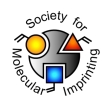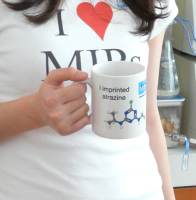
Authors: Liu DJ, Yang Q, Jin SS, Song YY, Gao JF, Wang Y, Mi HF
Article Title: Core-shell molecularly imprinted polymer nanoparticles with assistant recognition polymer chains for effective recognition and enrichment of natural low-abundance protein.
Publication date: 2014
Journal: Acta Biomaterialia
Volume: 10
Issue: (2)
Page numbers: 769-775.
DOI: 10.1016/j.actbio.2013.10.007
Alternative URL: http://www.sciencedirect.com/science/article/pii/S1742706113005151
Abstract: Core-shell molecular imprinting of nanomaterials overcomes difficulties with template transfer and achieves higher binding capacities for macromolecular imprinting, which are more important to the imprinting of natural low-abundance proteins from cell extracts. In the present study, a novel strategy of preparing core-shell nanostructured molecularly imprinted polymers (MIPs) was developed that combined the core-shell approach with assistant recognition polymer chains (ARPCs). Vinyl-modified silica nanoparticles were used as support and ARPCs were used as additional functional monomers. Immunoglobulin heavy chain binding protein (BiP) from the endoplasmic reticulum (ER) was chosen as the model protein. The cloned template protein BiP was selectively assembled with ARPCs from their library, which contained numerous limited-length polymer chains with randomly distributed recognition and immobilization sites. The resulting complex was copolymerized onto the surface of vinyl-modified silica nanoparticles under low concentrations of the monomers. After template removal, core-shell-structured nanoparticles with a thin imprinted polymer layer were produced. The particles demonstrated considerably high adsorption capacity, fast adsorption kinetics and selective binding affinities toward the template BiP. Furthermore, the synthesized MIP nanoparticles successfully isolated cloned protein BiP from protein mixtures and highly enriched BiP from an ER extract containing thousands of kinds of proteins. The enrichment reached 115-fold and the binding capacity was 5.4 μg g-1, which were higher than those achieved by using traditional MIP microspheres. The advantageous properties of MIP nanoparticles hold promise for further practical applications in biology, such as protein analysis and purification
Template and target information: protein, immunoglobulin heavy chain binding protein, BiP
Author keywords: molecular imprinting, Immunoglobulin heavy chain binding protein, silica nanoparticles, assistant recognition polymer chains, Endoplasmic reticulum



Join the Society for Molecular Imprinting

New items RSS feed
Sign-up for e-mail updates:
Choose between receiving an occasional newsletter or more frequent e-mail alerts.
Click here to go to the sign-up page.
Is your name elemental or peptidic? Enter your name and find out by clicking either of the buttons below!
Other products you may like:
 MIPdatabase
MIPdatabase









